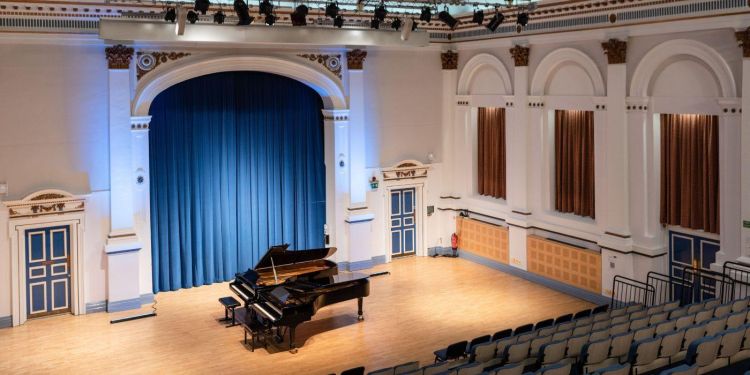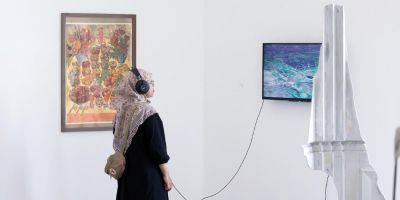Light Night 2024 to feature exhibits by AHC staff and researchers

Leading artists, researchers, technicians, and professional staff from across the Faculty will take part in the University of Leeds’ celebrations for this year’s Light Night
Leading artists, researchers, technicians, and professional staff from across the Faculty of Arts, Humanities and Cultures will take part in the University of Leeds’ celebrations for this year’s Light Night festival.
Light Night is an annual free multi-arts and light festival that transforms Leeds for two nights in October, attracting over 150,000 local and international visitors. Now in its 20th year, Light Night has become a cultural staple of the city, attracting over 1.1 million visitors in two decades, with last year’s event drawing a record 200,000 attendees.

This year’s event will run from 24-25 October and the University of Leeds will transform the heart of its campus with a host of large-scale light installations, immersive experiences and participatory activities for families. The programme showcases cutting-edge research, international commissions, student creativity and interdisciplinary collaboration, drawing inspiration from this year’s Smeaton300 programme theme: Inspired by Nature.
In addition to family-friendly indoor and outdoor activities, visitors will find a map with a suggested route though the campus, a quiet zone, a shuttle bus stop outside the Parkinson Building, free parking in the multi-storey car park, and plenty of hot refreshments available on campus
Staff from across the Faculty of Arts Humanities and Cultures will take part in this year’s programme. Here, two of the researchers shed light on their installations.
Kelly Cumberland, an artist and practice researcher in the School of Design, will exhibit her work alongside that of other next generation artists including Ed Green and Eleanor Craig. Her installation, Iteration LN24, fuses art and science, using light and shadow to highlight cellular processes. Working with neuroscientist researchers at St James’s Hospital, employed by the University of Leeds, Kelly emphasizes the shared role of observation among scientists, artists, and viewers through non-traditional drawing techniques.
"Light Night is the perfect space to explore the intersection of art and science," Kelly explains. "It allows me to experiment with light, perception, and space in ways that can lead to new discoveries, both for myself and the audience. My late supervisor, Judith Tucker, also encouraged me to bring my work to Light Night as a way to extend my research to new audiences."
The installation blends paper cutting, projection, light, and mirrors to create a space where scientific data meets artistic expression.
"The series of works builds a narrative that is serendipitous yet tangible," Kelly says. "It’s about breaking down barriers and encouraging reflection, opening up new perspectives on both art and science."
Iteration LN24 can be found at the Pyramid Theatre (inside Leeds University Union), Thursday & Friday from 6-10pm.
The School of Music’s Dan Merrick (Strategic Development Manager) and Dr Scott McLaughlin, Associate Professor in Composition and Music Technology, will host Smeaton’s Planetarium where star science and electronic music will collide to create a star-scattering, immersive experience in the beautiful surroundings of the Clothworkers’ Concert Hall. Three separate projection sources create a wrap-around visual, covering the internal walls of the Concert Hall to create a planetarium effect. The visuals - stars, galaxies and nebulae - melt and reform, in direct conversation with music created by students from the School of Music, inspired by the research of scientists from the School of Physics and Astronomy.
Dan Merrick has been involved with Light Nights in Leeds since they first began in 2005 and describes his excitement at this year’s installation.
“Momentary steps away from reality are a fundamental part of the Light Night adventure,” he says, “and while John Smeaton’s lifelong love of astronomy was the inspiration, Smeaton’s Planetarium will be sensory overload, an immersive, out of this world experience. It will be anything but a conventional planetarium. When you combine star chemistry data, electronic music compositions, live piano and reactive projection mapped visuals, the results are unmistakably other worldly. I’ve been lucky enough to see the visuals, as part of the design process, and can’t wait to experience the final version with room-shaking 4-speaker sound.This year’s contribution is a truly collaborative project: we’ve commissioned Leeds-based visual artist, and Light Night veteran, Paul Miller; Scott’s working with scientists from the School of Physics and Astronomy; and we’re platforming the work of five composers and two pianists – the addition of live piano interludes performed by two of our students will be the icing on the cake.”

Scott McLaughlin adds: “It's really interesting both to update Smeaton's understanding of the stars with Leeds' cutting-edge research into the specific chemical make-up of stars, and then to also work with students on translating that data into musical pieces. The students all brought very different ideas, and weren't afraid to push the data around so that it derives from the astrochemical observations but also doesn't pretend to be 'the sound of space molecules', instead allowing the science and art to sit beside each other and be fascinating in their own ways.”
The biggest challenge, Scott says, was translating the enormous amount of stellar chemistry data at their disposal into music and light.
“The students are taking literally millions of points of data for a single molecule and trying to encapsulate that in music in a meaningful way. The pieces all work so well because the composers followed their intuitions to connect with the data in a way that works for their music. To get around this challenge we were able to draw on the support of Dr Catherine Walsh in Astrochemistry, who guided us through the data and methods, explaining how it translated into the chemistry of the lives of stars.”
The composers took a variety of approaches to create their pieces, from the literal 'sonification' of the astrochemistry data, to more metaphorical pieces where musical ideas grow out of the composer's understanding of the science, reinterpreted through a musical lens. However, as Scott explains, the students have mostly created electronic music rather than pieces for musicians to play.
“This is partly because it better suits the installation context but also because translating millions of data points into sound is a task that computers were designed to handle. It gets around some of the complexities of the data leading to music that would be very difficult to play, or requiring hundreds of musicians.”
Smeaton’s Planetarium can be found at Clothworkers’ Concert Hall (12 Cavendish Road) Thursday 6-10pm & Friday 8-10pm.
Steve Ansell, Artistic Director and Theatre Manager, based in the School of Performance and Cultural Industries, will also be involved in the following projects:
Illuminating Edward Carpenter (stage@Leeds, Thursday and Friday, 6-10pm) – an immersive environment exploring the life of Edward Carpenter (1844-1929). Using sound, light, projection and Carpenter's extensive collection of letters, notebooks and photographs at the University of Leeds, the exhibition vividly brings to life the poet, philosopher and advocate for gay rights, women's rights and environmental causes.
Urban Jungle (stage@leeds, Thursday & Friday, 6 – 10pm) – a retro gaming environment with big screen, big sound and a distinctly jungle theme. Come and try old school gaming in a whole new way. Suitable for the entire family.
Cinchona -invisible light (stage@leeds, Thursday & Friday, 6 – 10pm) – an interactive installation that uses light, sound and movement to explore the fascinating properties of plants, especially Cinchona Bark, the natural source of quinine. Create an invisible forest by drawing unseen plants, enjoy a luminous drink and share nature in a new way. Family-friendly and fun for all ages.




